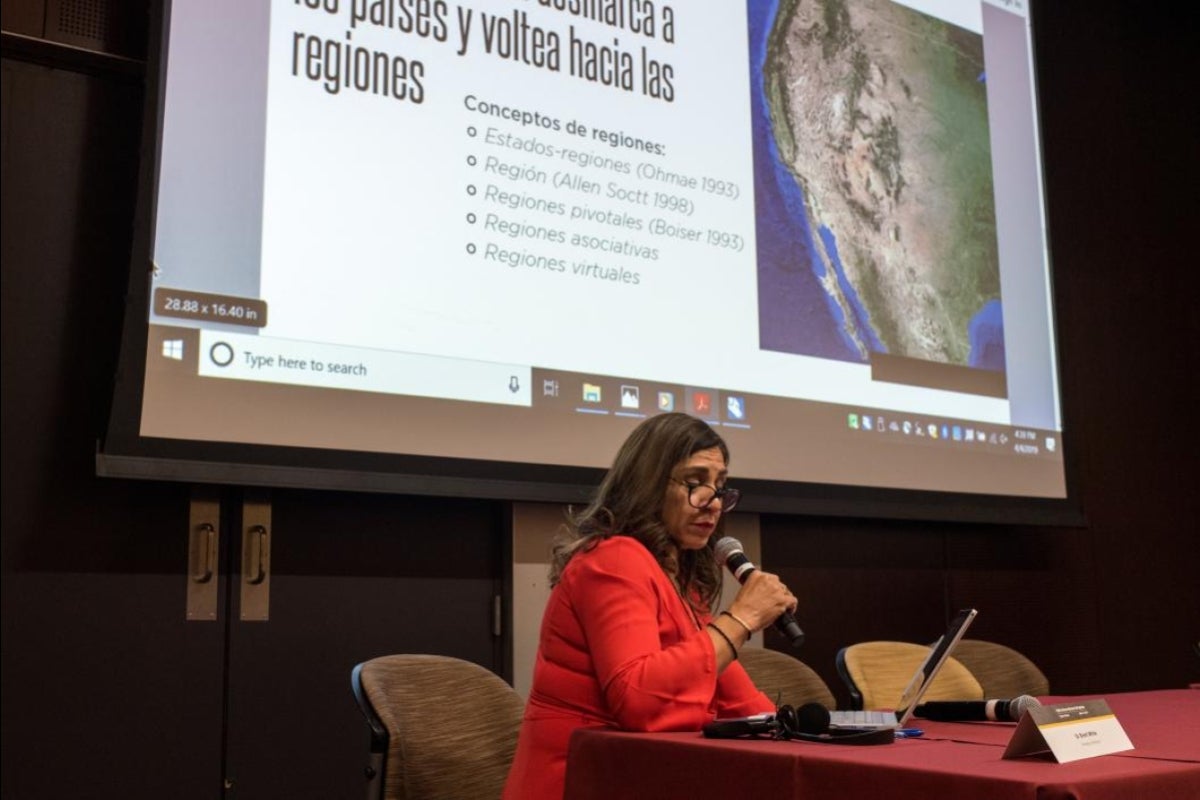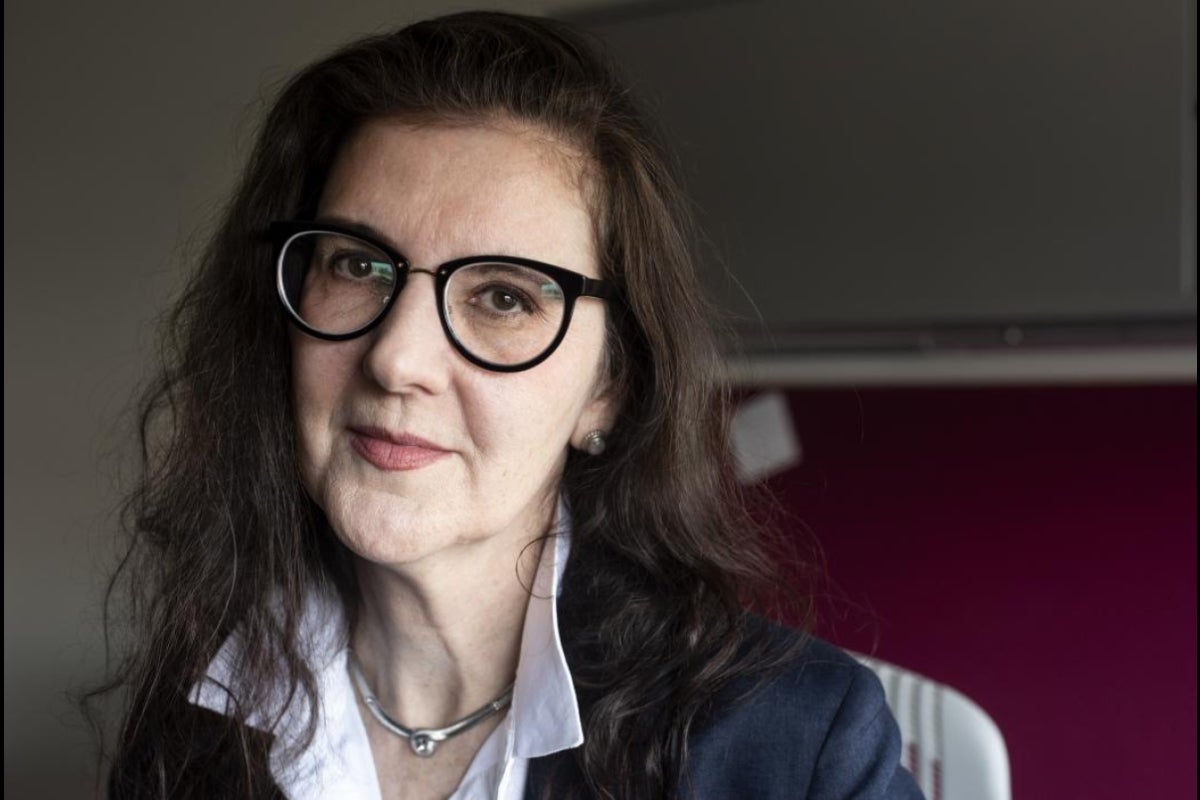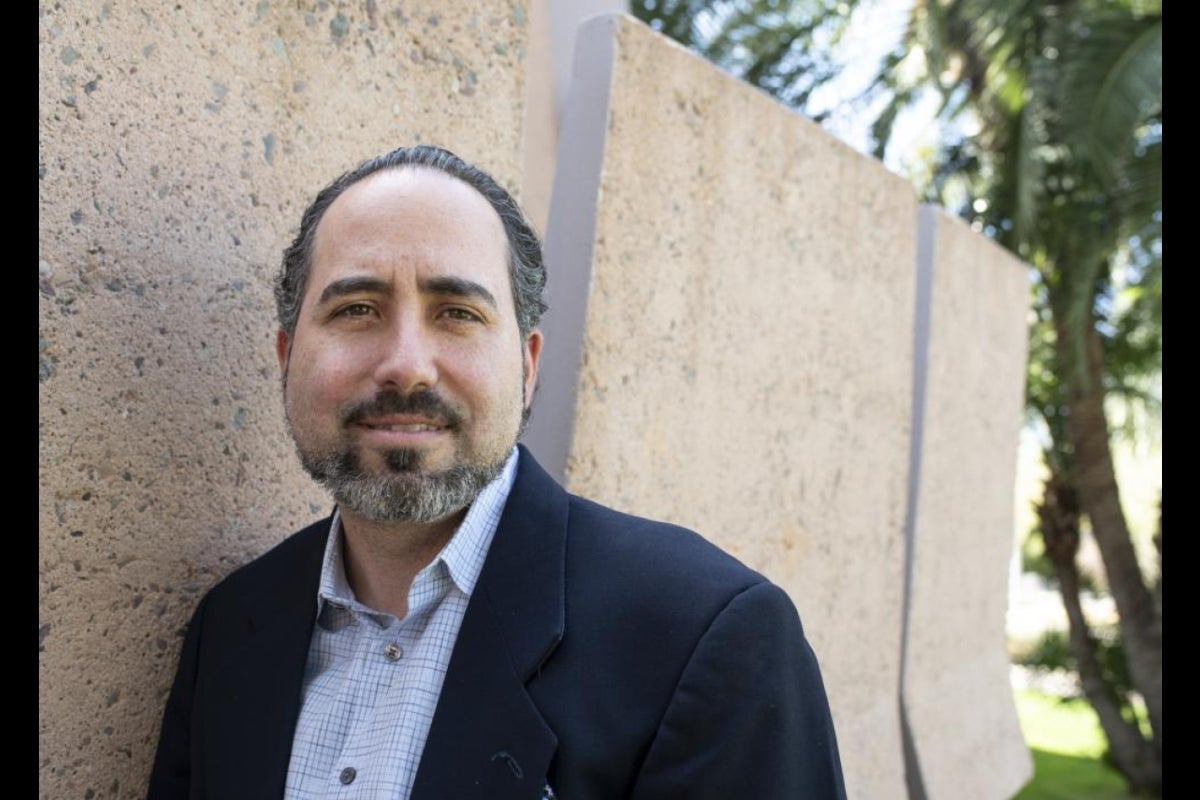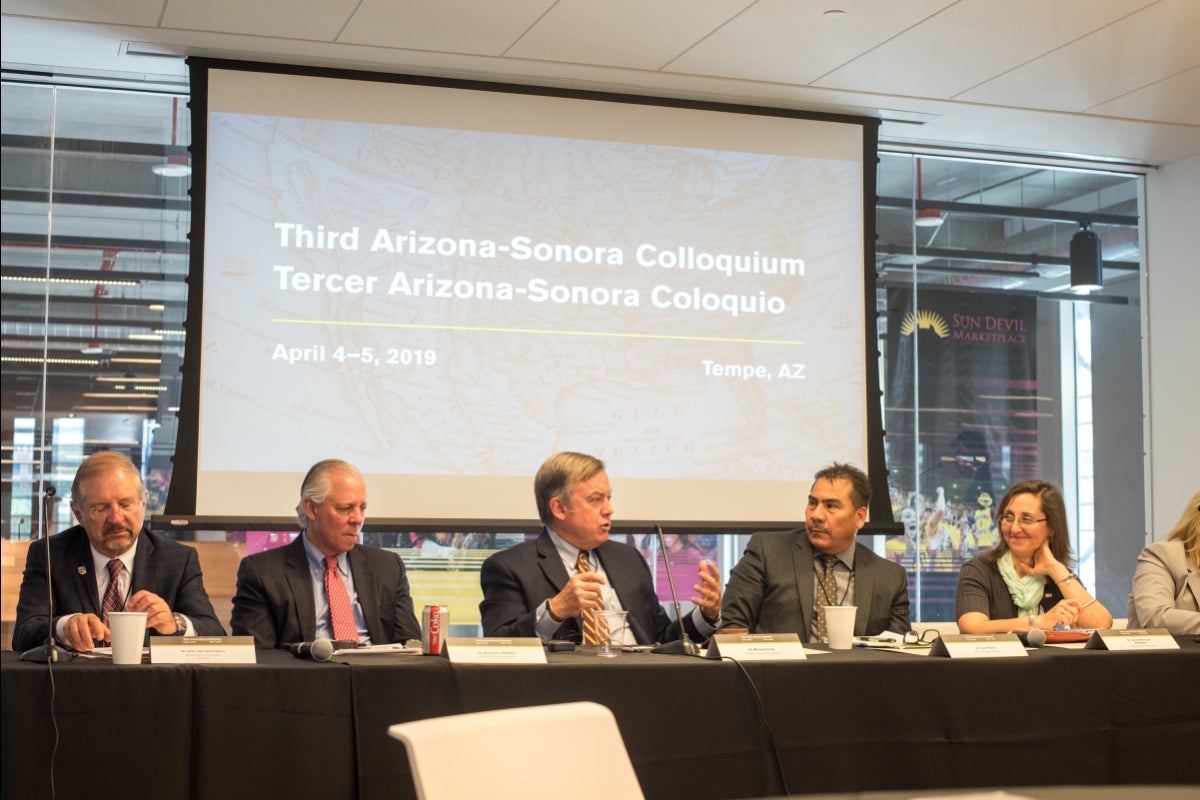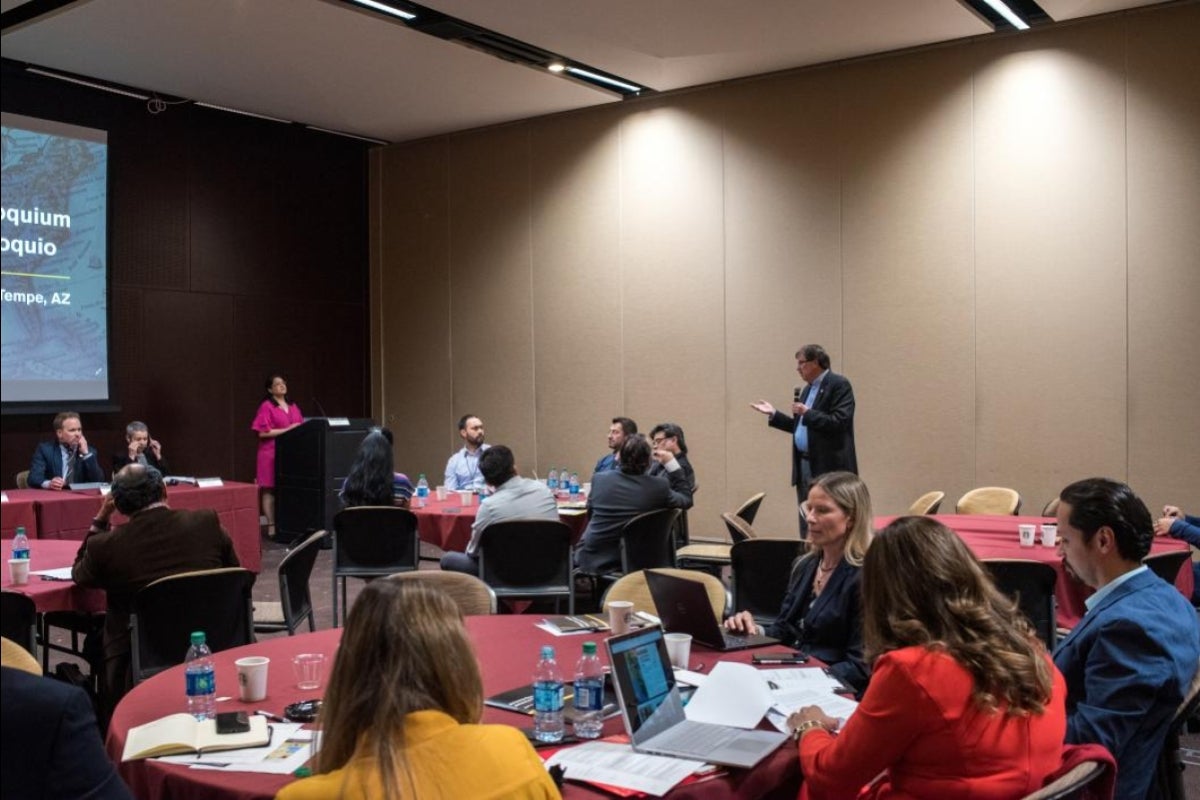Scholars redefine the border conversation at Arizona-Sonora Colloquium

ASU School of Transborder Studies Regents’ Professor and Founding Director Emeritus Carlos Velez-Ibanez moderates a panel discussion of social scientists from Arizona and Mexico at the Arizona-Sonora Colloquium. Photo by Alisa Reznick
The U.S.-Mexico border is a complicated mosaic of unpredictable policies and shifting economic tides. A patchwork of man-made and natural barriers spanning four U.S. states and almost 2,000 miles, the stretch is usually defined by the things it separates.
But at the Arizona-Sonora Colloquium, academics aimed to challenge that notion by reconnecting the area’s historic ties and forging a more sustainable future for both lands.
The biennial event convened for its latest session April 4–5 at Arizona State University and gathered researchers, university presidents and public policy representatives from across Arizona and Mexico’s northern state of Sonora to discuss how knowledge exchange can be used as a tool to build resiliency.
Rethinking the borderlands
Launched in 2015 by The College of Liberal Arts and Sciences’ School of Transborder Studies with support from the ASU Office of the President, the international conference and its parent initiative Program for Transborder Communities (PTC) spotlight the common ground of Arizona’s south and Mexico’s north.
Where others see a delineating borderline, PTC’s program director Lara-Valencia sees a transborder megaregion.
“This is a multidimensional space with cultural connections, economic interactions and environmental linkages that extend far beyond the border itself,” said Lara-Valencia, also an associate professor in the School of Transborder Studies. “Through research and knowledge sharing, we are trying to find ways to overcome the barrier effect of the border and facilitate the processes of interaction that happen on a daily basis here.”
One example Lara-Valencia points to is in the twin cities of Nogales, Arizona and Nogales, Sonora, a border zone that sees around 10 million people each year passing through its two entry ports. In addition to being an active trade and familial corridor, both cities are sustained by the Santa Cruz River. The survival of each place depends on its ability to manage resources effectively, meaning collaboration is imperative.
“Institutions on both sides must work together to ensure they have that water supply for generations to come,” Lara-Valencia said. “If they do not, they risk the future of their entire communities.”
The situation is not unique to Nogales. Several urban centers across the region may face daunting futures without electricity, food and water resource management that works for both countries.
“Relations at the federal and national level are at a complicated place, but there is more uniting us than dividing us,” said Manuel Valenzuela, director of innovation and internationalization at the Universidad de Sonora. “By gathering ideas, we can strengthen and amplify collaboration.”
Valenzuela was one of several institutional leaders, including ASU President Michael Crow, Northern Arizona University President Rita Cheng and University of Arizona President Robert Robbins, at the colloquium. Held in either Tempe or Sonora’s capital Hermosillo, the event is the staging ground for the cross-border scholarship Lara-Valencia and other PTC founders originally envisioned.
“The colloquium and PTC as a whole are both mechanisms to create narratives of understanding, cooperation and commonalities between the U.S. and Mexico,” Lara-Valencia said. “I think it also challenges what you normally see in the media about this region to help people see that the reality of the border is much more complex.”
Funding impactful research
Still, creating a platform for meaningful discourse is neither easy, nor free. In 2014, the Office of the President helped bridge the gap by allocating over $1 million to PTC’s research grant initiative to fund research projects partnering ASU faculty with academics from institutions in Sonora and other border regions.
The grant program has since expanded to include funding and participants from several institutions in Mexico and the University of Arizona. Through the Arizona-Sonora Interuniversity Alliance, the money has helped fund over 20 projects so far. A call for research proposals for the 2019 cycle is forthcoming this spring, and now also includes Northern Arizona University, El Colegio de la Frontera Norte and Instituto Tecnológico de Sonora.
At the two-day colloquium, participants and seed grant recipients had the chance to discuss research barriers face-to-face and plan for the future.
Angela Arzubiaga, an associate professor in The College’s School of Social Transformation, is one of the 2018 grant recipients. Arzubiaga and ASU colleagues Jessica Solyom and Nicholas Bustamante will partner with El Colegio de Sonora’s Gabriela García Figueroa, Valentina Glockner Fagetti and Nohora Constanza Niño Vega for a project following the journeys of Central American children through Mexico and the U.S. as they apply for asylum.
The topic has dominated national headlines over the last few years, but Arzubiaga said little has been done to look at what happens to young people after their initial arrival. The ASU researcher, whose work has examined how a range of institutions impact immigrant lives, said coordinating with her Sonoran counterparts gives the project more depth.
“The collaboration allows us to question what we take for granted,” she said. “It not only provides different perspectives on the work itself, but affords participating students with opportunities that are globally relevant.”
Thinking about the big picture is also how Enrique Vivoni, a concurrent professor in The College’s School of Earth and Space Exploration and the School of Sustainable Engineering and the Built Environment, approached his grant project in 2016.
Back then, Vivoni partnered with Instituto Tecnológico de Sonora academic Agustín Robles-Morua and El Colegio de Sonora’s Rolando Enrique Díaz Caravantes for a comparative study of urban sustainability in Phoenix and Hermosillo.
Each sitting several hours from the international line and each other, neither of the Sonoran Desert cities seems particularly tied to border studies at first glance. But the sprawling capitals actually share a lot. Both rely on seasonal monsoons that are increasingly threatened by the impacts of climate change, while the desert’s arid landscape means resource management and allocation systems are crucial to their survival.
As the study progressed, Vivoni said the project built upon itself by exploring new facets.
“Both are cities trying to grow in very harsh climatic conditions, that’s how our work started,” Vivoni said. “As we went on, we started looking at more local aspects like water conservation, storm water control and the use of green spaces to reduce urban heat.”
Three years later, the project has tangible results.
“We created a visualization tool for Hermosillo that informs residents about heat waves and details areas in the city that are more susceptible to higher temperatures,” said Vivoni, who also serves as associate dean of ASU’s Graduate College. “That came directly from our collaboration in PTC.”
Scholarship for a revamped region
Vivoni said studies done through the program should be a springboard for new generations of scholars to drive cross-border research forward and, when possible, spur change and offer solutions.
That sentiment was echoed by the director of the Sonora government’s international cooperation office, Yamilett Martínez, who asked scholars at the colloquium to consider how their work could have impacts outside the classroom.
“The Arizona-Sonora commission needs the knowledge you are generating to have public policy outcomes go hand in hand,” she said. “We ask that you, the academics, demand our attention to continue to make progress in the executive offices in both states.”
Wielding academic innovation as a means of social change has been one of the PTC’s major goals since its inception. April’s colloquium drove that idea forward with a roundtable event gathering university leaders to discuss how collaboration has helped shape policy thus far, and what more can be done.
“Our states together represent 180,000 square miles of territory with unbelievable natural assets, unbelievable natural beauty and unbelievable potential,” Crow said. “There is no future economy for which education is not important, no success for which universities are not important; let’s set aside the politics and rhetoric going on (on the national level) and figure out how we can be a more successful region.”
More Science and technology

ASU to host 2 new 51 Pegasi b Fellows, cementing leadership in exoplanet research
Arizona State University continues its rapid rise in planetary astronomy, welcoming two new 51 Pegasi b Fellows to its exoplanet…

ASU students win big at homeland security design challenge
By Cynthia GerberArizona State University students took home five prizes — including two first-place victories — from this year’s…

Swarm science: Oral bacteria move in waves to spread and survive
Swarming behaviors appear everywhere in nature — from schools of fish darting in synchrony to locusts sweeping across landscapes…


